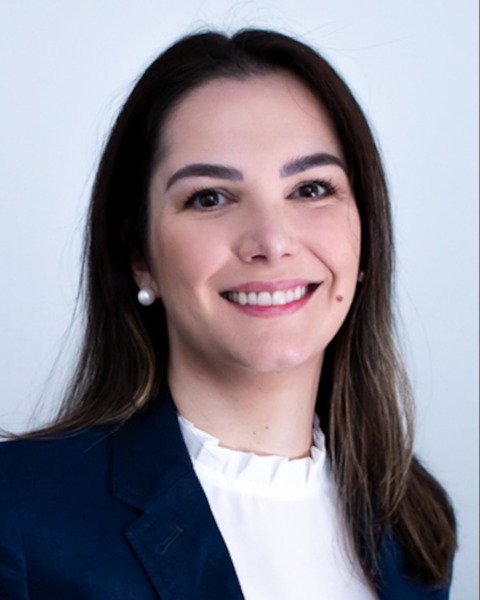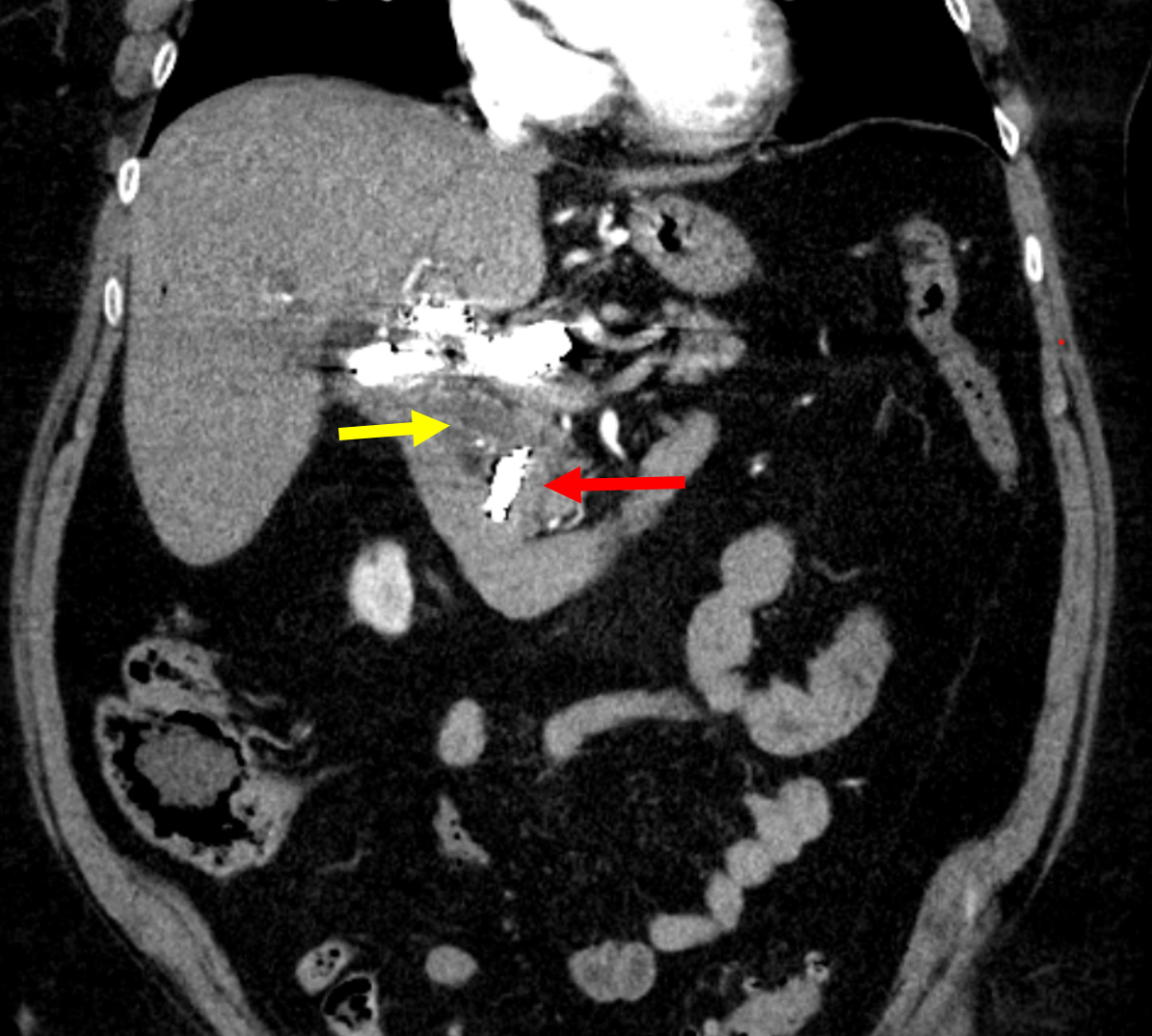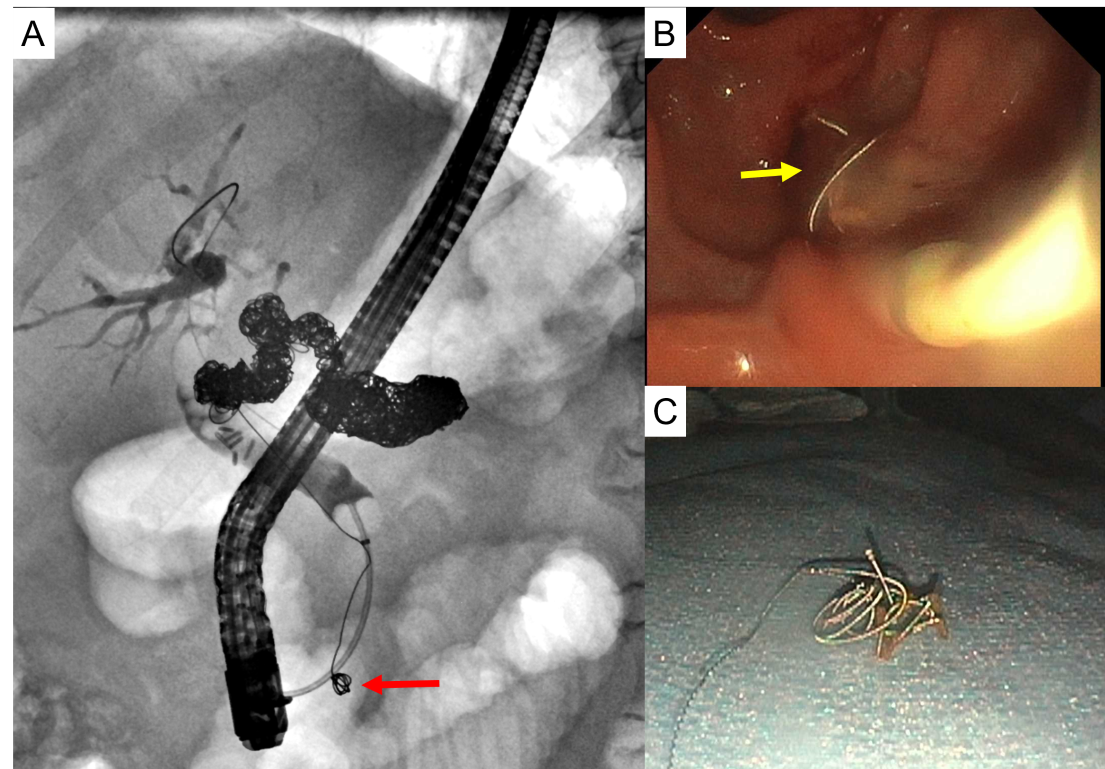Tuesday Poster Session
Category: Biliary/Pancreas
P4504 - Vascular Coil Migration: A Rare Cause of Post-Embolization Biliary Obstruction and Cholangitis
Tuesday, October 28, 2025
10:30 AM - 4:00 PM PDT
Location: Exhibit Hall

Fernanda Pessorrusso, MD, PhD (she/her/hers)
University of Colorado Anschutz Medical Campus
Erie, CO
Presenting Author(s)
Fernanda Pessorrusso, MD, PhD1, Thomas Enke, MD2, Blake Niccum, MD3, Anna Duloy, MD3, Steven Edmundowicz, MD4, Mohammad Bilal, MD, FACG5
1University of Colorado Anschutz Medical Campus, Erie, CO; 2University of Colorado, Aurora, CO; 3University of Colorado Anschutz Medical Campus, Aurora, CO; 4University of Colorado Anschutz Medical Campus, Epaurora, CO; 5University of Colorado Anschutz Medical Campus, Denver, CO
Introduction: Migration of embolization coils to the biliary tree is a rare complication following interventional radiology (IR) embolization of the hepatic arteries. The pathophysiology often involves fistulation of the coil into the adjacent biliary ducts, likely facilitated by local tissue necrosis, infection, or persistent inflammation at the coil placement site. We report a case of cholangitis secondary to migration of embolization coils from the hepatic artery into the common bile duct.
Case Description/
Methods: A 71-year-old woman with a history of cholecystectomy initially presented with haemobilia and biliary obstruction secondary to a pseudoaneurysm of the right and common hepatic arteries with fistulous connection to the biliary tree. Coil embolization of the common and right hepatic arteries was performedby IR.
Endoscopic retrograde cholangiopancreatography (ERCP) the next day revealed extrinsic compression of the common hepatic duct and a fully covered self-expanding metal stent (FCSEMS) was placed. The stent was removed two months later. No apparent stricture was seen on cholangiogram and stent placement was deferred.
Two months later, she was readmitted with ascending cholangitis. Computed tomography angiographyrevealed migration of the embolization coils into the distal common bile duct (CBD) (Figure 1). ERCP revealed a mild stricture of the upper third of the CBD adjacent to the embolization coils likely secondary to external compression and/or local ischemic changes. The bile duct was swept with an extraction balloon revealing an unraveled embolization coil which was successfully removed (Figure 2). A plasticstent was placed across the CBD stricture.
Two months later a follow-up ERCP demonstrated persistent CBD stricture adjacent to the embolization coils. Two additional embolization coils were swept from the CBD and a plastic stent was placed. One month later, repeat ERCP was performed following stent migration into the small bowel. Cholanigogramdemonstrated a persistent CBD stricture. No coils were found in the biliary tree and a FCSEMS was placed across the stricture. No further complications have occurred 2 months later.
Discussion: Although rare, clinicians should maintain a high level of suspicion for coil migration in patients with a history of hepatic artery embolization who present with cholangitis or biliary obstruction. FCSEMS placement across the fistulous tract may decrease the risk of recurrence.

Figure: Figure 1. Computed tomography angiography with coil migration into the distal common bile duct (red arrow) and upstream biliary dilation (yellow arrow).

Figure: Figure 2. Cholangiogram demonstrating an unraveled embolization coil in the distal common bile duct (A) with subsequent removal during endoscopic retrograde cholangiopancreatography (B, C).
Disclosures:
Fernanda Pessorrusso indicated no relevant financial relationships.
Thomas Enke indicated no relevant financial relationships.
Blake Niccum indicated no relevant financial relationships.
Anna Duloy indicated no relevant financial relationships.
Steven Edmundowicz: Aspero Medical – Advisory Committee/Board Member, Intellectual Property/Patents, Stock Options, Stock-privately held company. Bariendo – Advisory Committee/Board Member. Boston Scientific – Consultant. Dragonfly Endoscopy – Advisory Committee/Board Member, Consultant, Stock Options. Fractyl – Advisor or Review Panel Member, Consultant. Medpace – Consultant. Olympus America – Advisory Committee/Board Member, Consultant.
Mohammad Bilal: Boston Scientific – Consultant. Cook endoscopy – Paid speaker. Steris Endoscopy – Consultant.
Fernanda Pessorrusso, MD, PhD1, Thomas Enke, MD2, Blake Niccum, MD3, Anna Duloy, MD3, Steven Edmundowicz, MD4, Mohammad Bilal, MD, FACG5. P4504 - Vascular Coil Migration: A Rare Cause of Post-Embolization Biliary Obstruction and Cholangitis, ACG 2025 Annual Scientific Meeting Abstracts. Phoenix, AZ: American College of Gastroenterology.
1University of Colorado Anschutz Medical Campus, Erie, CO; 2University of Colorado, Aurora, CO; 3University of Colorado Anschutz Medical Campus, Aurora, CO; 4University of Colorado Anschutz Medical Campus, Epaurora, CO; 5University of Colorado Anschutz Medical Campus, Denver, CO
Introduction: Migration of embolization coils to the biliary tree is a rare complication following interventional radiology (IR) embolization of the hepatic arteries. The pathophysiology often involves fistulation of the coil into the adjacent biliary ducts, likely facilitated by local tissue necrosis, infection, or persistent inflammation at the coil placement site. We report a case of cholangitis secondary to migration of embolization coils from the hepatic artery into the common bile duct.
Case Description/
Methods: A 71-year-old woman with a history of cholecystectomy initially presented with haemobilia and biliary obstruction secondary to a pseudoaneurysm of the right and common hepatic arteries with fistulous connection to the biliary tree. Coil embolization of the common and right hepatic arteries was performedby IR.
Endoscopic retrograde cholangiopancreatography (ERCP) the next day revealed extrinsic compression of the common hepatic duct and a fully covered self-expanding metal stent (FCSEMS) was placed. The stent was removed two months later. No apparent stricture was seen on cholangiogram and stent placement was deferred.
Two months later, she was readmitted with ascending cholangitis. Computed tomography angiographyrevealed migration of the embolization coils into the distal common bile duct (CBD) (Figure 1). ERCP revealed a mild stricture of the upper third of the CBD adjacent to the embolization coils likely secondary to external compression and/or local ischemic changes. The bile duct was swept with an extraction balloon revealing an unraveled embolization coil which was successfully removed (Figure 2). A plasticstent was placed across the CBD stricture.
Two months later a follow-up ERCP demonstrated persistent CBD stricture adjacent to the embolization coils. Two additional embolization coils were swept from the CBD and a plastic stent was placed. One month later, repeat ERCP was performed following stent migration into the small bowel. Cholanigogramdemonstrated a persistent CBD stricture. No coils were found in the biliary tree and a FCSEMS was placed across the stricture. No further complications have occurred 2 months later.
Discussion: Although rare, clinicians should maintain a high level of suspicion for coil migration in patients with a history of hepatic artery embolization who present with cholangitis or biliary obstruction. FCSEMS placement across the fistulous tract may decrease the risk of recurrence.

Figure: Figure 1. Computed tomography angiography with coil migration into the distal common bile duct (red arrow) and upstream biliary dilation (yellow arrow).

Figure: Figure 2. Cholangiogram demonstrating an unraveled embolization coil in the distal common bile duct (A) with subsequent removal during endoscopic retrograde cholangiopancreatography (B, C).
Disclosures:
Fernanda Pessorrusso indicated no relevant financial relationships.
Thomas Enke indicated no relevant financial relationships.
Blake Niccum indicated no relevant financial relationships.
Anna Duloy indicated no relevant financial relationships.
Steven Edmundowicz: Aspero Medical – Advisory Committee/Board Member, Intellectual Property/Patents, Stock Options, Stock-privately held company. Bariendo – Advisory Committee/Board Member. Boston Scientific – Consultant. Dragonfly Endoscopy – Advisory Committee/Board Member, Consultant, Stock Options. Fractyl – Advisor or Review Panel Member, Consultant. Medpace – Consultant. Olympus America – Advisory Committee/Board Member, Consultant.
Mohammad Bilal: Boston Scientific – Consultant. Cook endoscopy – Paid speaker. Steris Endoscopy – Consultant.
Fernanda Pessorrusso, MD, PhD1, Thomas Enke, MD2, Blake Niccum, MD3, Anna Duloy, MD3, Steven Edmundowicz, MD4, Mohammad Bilal, MD, FACG5. P4504 - Vascular Coil Migration: A Rare Cause of Post-Embolization Biliary Obstruction and Cholangitis, ACG 2025 Annual Scientific Meeting Abstracts. Phoenix, AZ: American College of Gastroenterology.
